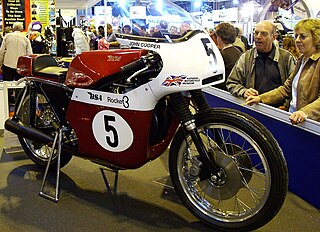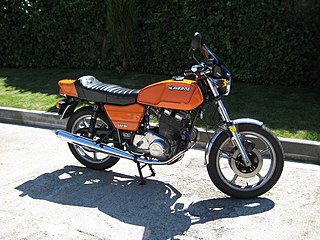
Monocoque, also called structural skin, is a structural system in which loads are supported by an object's external skin, in a manner similar to an egg shell. The word monocoque is a French term for "single shell".

The Norton Motorcycle Company is a brand of motorcycles headquartered in Solihull, West Midlands,, England. For some years around 1990, the rights to use the name on motorcycles was owned by North American financiers.

The term semi-monocoque or semimonocoque refers to a stressed shell structure that is similar to a true monocoque, but which derives at least some of its strength from conventional reinforcement. Semi-monocoque construction is used for, among other things, aircraft fuselages, car bodies and motorcycle frames.

The Commander was a Norton motorcycle with a Wankel rotary engine.

A café racer is a genre of sport motorcycles that originated among British motorcycle enthusiasts of the early 1960s in London. Café racers were standard production bikes that were modified by their owners and optimized for speed and handling for quick rides over short distances. Café racers have since become popular around the world, and some manufacturers produce factory-made models that are available in the showrooms.

The Norton Commando is a British Norton-Villiers motorcycle with an OHV pre-unit parallel-twin engine, produced by the Norton Motorcycle company from 1967 until 1977. Initially having a nominal 750 cc displacement, actually 745 cc (45.5 cu in), in 1973 it became an 850 cc, actually 828 cc (50.5 cu in). It had a hemi-type head, similar to all OHV Norton engines since the early 1920s.

A motorcycle frame is a motorcycle's core structure. It supports the engine, provides a location for the steering and rear suspension, and supports the rider and any passenger or luggage. Also attached to the frame are the fuel tank and battery. At the front of the frame is found the steering head tube that holds the pivoting front fork, while at the rear there is a pivot point for the swingarm suspension motion. Some motorcycles include the engine as a load-bearing stressed member; while some other bikes do not use a single frame, but instead have a front and a rear subframe attached to the engine.

Paul Smart was an English short circuit motorcycle road racer who later entered Grands Prix.

Peter Williams was a British former professional motorcycle racer. He competed in Grand Prix motorcycle road racing from 1966 to 1973. He also competed at many levels on home short-circuit races. He raced many times on the Isle of Man TT course from 1966 to 1973. His father was Jack Williams who ran the Associated Motor Cycles (AMC) race department. Williams trained in mechanical engineering and introduced via racing alloy wheels, an innovation which is commonplace on today's road bikes, and was also an early pioneer of solo-motorcycle disc brakes.

The Norton Classic is a rotary-engined motorcycle built in 1987 by Norton as a special edition of just 100 machines.

The featherbed frame was a motorcycle frame invented by the McCandless brothers and offered to the British Norton motorcycle company to improve the performance of their racing motorcycles in 1950. It was considered revolutionary at the time, and the best handling frame that a racer could have. Later adopted for Norton production motorcycles, it was also widely used by builders of custom hybrids such as the Triton, becoming legendary and remaining influential to this day.

The BSA/Triumph racing triples were three cylinder 750 cc racing motorcycles manufactured by BSA/Triumph and raced with factory support from 1969-1974. There were road racing, production racing, endurance racing and flat track variants. The machines were based on the road-going BSA Rocket 3/Triumph Trident.

The Norton Commando Production Racer was a hand built production racer produced by Norton-Villiers from 1970 - 1972. It was based on the road-going Norton Commando, and although fitted with lights it was never intended as a road bike. The model was commonly known as the Yellow Peril.

The John Player Norton, also referred to as JPN and JPS Norton, were a series of Formula 750 racers manufactured by Norton Motorcycle Company from 1972 to 1974 and sponsored by cigarette manufacturer John Player. The engine for these machines was derived from the unit used in the Norton Commando, which was a development of the 1948 Bert Hopwood designed 500 cc Dominator. The lack of power from the engine, compared with other manufacturers, led designer and rider Peter Williams to a adopt a radical approach to chassis design. Riders of the bikes included Williams, Phil Read, Tony Rutter, Mick Grant, John Cooper, Dave Aldana and Dave Croxford.

The Norton Interpol was a police motorcycle produced by the British manufacturer Norton between 1969 and 1976. The Interpol was based on the company's Commando model. The 'Interpol' name was retained for Norton's later Norton Interpol 2 rotary engined police motorcycle.

The Norton Model 99 Dominator was a 600 cc vertical twin motorcycle manufactured by the British Norton Motorcycle Company at their Bracebridge St, Birmingham factory from 1956 to 1962. The 99 was based on the 500 cc Model 88 Dominator with an enlarged engine. The model was superseded by the 650SS.
The Norton Manxman was a 650 cc vertical twin motorcycle manufactured by the British Norton Motorcycle Company at their Bracebridge St, Birmingham factory for export. The engine was an enlargement of the 600 cc engine used in the Model 99 Dominator. The Manxman was first shown at the November 1960 Earls Court Motorcycle Show and listed by the American importer, Berliner, in their catalogue from 1961 to October 1962 Berliner had asked for the model to be named Manxman although the twin had never been raced at the Isle of Man.

The Laverda 750SFC is a hand-built 744 cc (45.4 cu in) air cooled SOHC 4 stroke parallel twin production racing motorcycle produced by the Italian manufacturer Laverda from 1971-1976. It was developed from the company's 750SF and drew from the racers used at the 1970 Bol d'Or. Finished in orange with a distinctive half-fairing, the machine was made in batches, with each batch identified by the frame number range. In total 549 SFCs were manufactured.

The Laverda 350/500 is a series of 345 cc (21.1 cu in) and 497 cc (30.3 cu in) air cooled DOHC 4 stroke parallel twin motorcycles produced by the Italian manufacturer Laverda from 1977 to 1983. The engine was used as the basis of future 650, 650, 668 and 750 cc models. Around 5,000 of these models were produced in total.
The Norton Challenge P86, also known as the Norton Cosworth, is a racing motorcycle designed in 1973 by Keith Duckworth of Cosworth Engineering for Norton Motorcyles. The 750 cc (46 cu in) DOHC vertical twin was essentially two cylinders from Cosworth's world championship winning V8 DFV Formula One engine. A road going version was intended to be a replacement for the Norton Commando. Four complete machines and around 30 engines were made before the project was cancelled due to the financial collapse of NVT.



















